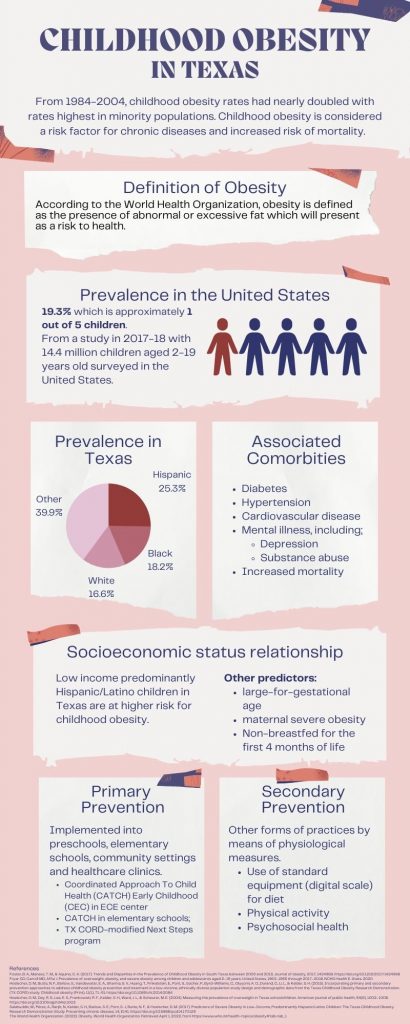Acknowledgements:
I would like to thank Dr. Lori Boies for her help in the early stages of this project, particularly in helping me find a topic I am passionate about. I am most grateful to my parents for their encouragement to help me to see the importance of this project for how it could be helpful and useful to others in need of information.



60 comments
Gaitan Martinez
In school, I would always laugh at the fact that kids would sarcastically say, “Thanks Michelle Obama,” for changing school lunches. In reality, it was needed because childhood obesity was increasing, and children were being fed school lunches with a lot of grease and trans fats. Again, as a community, we should definitely encourage others, especially kids, to eat healthier and exercise more.
Olivia Flores
Hey Xena. I really liked your infographic and it is such an important topic to talk about. I feel as though many people are unaware that it is a genuine problem in the country that will make a lot of work to fix. I liked how you gave certain solutions to this issue involving schools implementing more healthy options for lunches. As your data shows majority minority children are facing this problem and this is because they don’t have the funds to eat healthier ad it can be so expensive. Overall I enjoyed this infographic and the information it provided.
Juan Aguirre Ramirez
This article is very relevant in different ways, one of it is how it shows how obesity in Texas has reached at one point where 1 out of 5 children is obese. The author provided more information on how minorities, especially Hispanics, are more prevalent in Texas and the impact that this has on children’s health. And finally, the primary and secondary prevention was a good way to deal with obesity since it gave different methods and solutions to reduce obesity.
Karah Renfroe
I enjoyed reading this infographic. As someone that already has background knowledge on this topic, I believe the infographic dissected the topic enough for a wide range of individuals to understand (despite their potential lack of background on the topic). I liked the simple color layout, design and visuals. I also found the focus on Texas to be a good scope of study and enjoyed the detail given to the stats provided. Prevention methods at the end of the infographic particularly stood out to me.
Illeana Molina
After having viewed various infographics, I do enjoy each one and like to see everyone’s thoughts and passions come to life. However, I wish there was more education and guidance as to how to prevent it or what to do to maintain a healthy weight and lifestyle. I know it stated primary and secondary prevention but maybe tips and tricks as to what we can do to improve one’s health. I understand the main focus is obesity among children in Texas; it is incredibly prevalent and well-known, especially in our area. It is a great topic that I would love to see more info and research on. Overall, I did enjoy the information, the colors as well as the statistics. Greta Job !!
Karicia Gallegos
I thought this infographic was very informative. Childhood Obesity is a very important issue that needs more awareness on. I did not know that childhood obesity rates nearly doubled with rates highest in minority populations in 1984 to 2004. Something else that I learned from reading this infographic is that 1 out of 5 children are considered obese. Overall, the author did a great job, this infographic was very well written.
Alexis Zepeda
Hello Xena! I loved the information mentioned in this infographic. When creating an infographic, it is common to only list the factors that directly cause the problem, however, I loved that you mentioned socioeconomic statuses does correlate to childhood obesity. Socioeconomic status is a factor many tend to omit when thinking about childhood obesity because many assume it is one’s issue with the consumption of food. I think mentioning this factor is highly important and informative because not only is it a problem with how much someone is consuming rather the quality of food a person is consuming. I loved this infographic!
Carina Martinez
Wow! This infographic was shocking to me because not many people discuss how childhood obesity affects Texans. I also did not realize how wide-scale the issue was in Texas. You did a very good job of informing people on this issue while providing a pleasing graphic.
Naya Harb
It was crazy to find out that 1 out of 5 children are obese in the United States! The risk of being obese is not at all your “looks” it is just unhealthy for your body. So many diseases and health problems occur because of excess body weight. The fact that “poor” people have more chances to be obese than rich people is really interesting to me. This just proves that in the United States, being healthy is not prioritized, I have noticed that healthy foods are expensive here and fast food is cheap. So I can understand that lower-income families have a higher chance of having obese children. I also really liked that things are happening to prevent this problem. This was a really interesting and well-informed infographic. Thank you!
Jacqueline Galvan
I enjoyed this infographic because it touched on all aspects of diabetes in children, including the prevention, statistics, and relationship to socioeconomic status, among other things. I enjoyed the statistics especially, and I thought this infographic did a really good job at depicting them in an easy to understand format. I also appreciated the definition of obesity, and thought that it did an excellent job of educating on the simplest level.